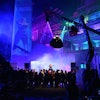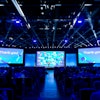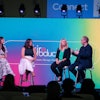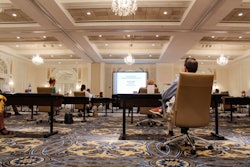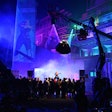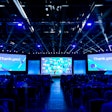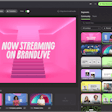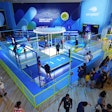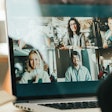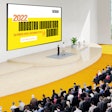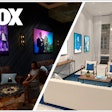
WASHINGTON, D.C.—Earlier this month, U.S. President Joe Biden gathered over 100 world leaders for the first-ever Summit for Democracy, with the goal of bolstering democracies around the world in the face of rising authoritarianism, which he called the "defining challenge" of the current era.
The two-day virtual event, which was produced by global event agency Freeman, kicks off an international “year of action” where countries across the world, including the U.S., will aim to strengthen democracy at home and abroad, all followed by an in-person assembly in late 2022. Originally intended to be held in person, this year’s virtual conference featured a schedule of speeches by heads of state, as well as meetings with leaders, cabinet members, civil society groups and human rights activists.
BizBash chatted with Mike Wohlitz, senior vice president at Freeman, about the unique challenges, including security concerns and last-minute changes, of producing an international gathering of this scale, as well as coordinating with speakers who are "busy running the world."
How did the partnership with the State Department come about?
This RFP went out to a number of bidders, and the driving interest for the Department of State was to create an international summit that would historically have been a face-to-face event and create a similar and compelling experience, understanding that because of travel restrictions, this summit was going to need to be hosted virtually. Once awarded the work, Freeman worked carefully with both the Department of State and also the White House to then make sure we delivered the administration's vision for the summit.
The overdriving approach was to have an international summit hosted virtually, but whenever possible create as much of an experience for the heads of state and other participants to make it feel as if they're in the same room, and so they could have both public and private conversations very directly with everyone involved in each of the summit sessions.
When did the planning start?
It was quite a dash. The project was awarded in early October, and that left six to eight weeks to then flesh out what the vision was and deliver on it on a number of different levels. Of course, with anything virtual, there's the platform that supports and hosts the entire summit. As you might imagine, given the sensitivity of this audience, security and reliability were a very driving factor in how we deployed the platform for the solution as well as registration. How do we ensure that the heads of state could get into a session, but only heads of state could be admitted to the session? There was a very significant platform and registration piece in that preproduction planning.
Then, of course, there was a broadcast component. How do we create an environment that is compelling for the participants amongst themselves, as well as to create a compelling atmosphere to share for broadcast with the rest of the public and the press who could then watch and observe the streams of much of the summit? I would say about 80% or more of the summit was shared publicly versus private and discreet conversations.
As one might expect, with anything with the government, the actual content of what we were saying came in at the very last minute. And when I say last minute, oftentimes the day before. We might have known who was speaking and when but that was it. We were getting teleprompter scripts the day out. We were receiving a lot of that direction, less than 24 hours out, because that's normal for a lot of world leaders. They're very busy running the world, so that takes priority over speech writing. We knew that. If you know that that's going to be the case, you plan for it, so you can accomplish it as best as possible.
 "Knowing the sensitivity with heads of state, we worked with the United States government to make sure that the platform met their very stringent security needs," said Mike Wohlitz, senior vice president at Freeman.Photo: Courtesy of Freeman
"Knowing the sensitivity with heads of state, we worked with the United States government to make sure that the platform met their very stringent security needs," said Mike Wohlitz, senior vice president at Freeman.Photo: Courtesy of Freeman
Regardless of who the client is, whether it is corporations, whether it's a medical association, whether it's the U.S. government, everybody has security as one of their top concerns with virtual, and that's something we take very seriously. Knowing the sensitivity with heads of state, we worked with the United States government to make sure that the platform met their very stringent security needs. They spent quite a bit of effort reviewing our external audits of the security of our system and penetration testing to ensure that it met the needs of the United States government.
I'm very proud to say that given that audit, no additional changes were needed to our platform. We checked all the boxes based on their needs after that assessment. But again, everyone's going to have that concern for their event. They want to make sure the right people are in and the wrong people aren't. It's really a function of two different but related elements. One is the platform itself to make sure that it cannot be penetrated by malicious effort, and the other is registration.
How the attendees get in and out of the sessions and make sure that heads of state get into the correct session and people who could watch but not speak in some of the private sessions could get in and out as need be, and then also to make sure that we could then share the public session as needed with the press and the public. It's those two pieces—the platform and the registration module working together. In our case, we're very fortunate that it was our platform and our registration model working together so it allowed us to control how those two functions worked together.
 A secure studio was set up on the White House grounds, along with three more additional studios in the Washington Convention Center.Photo: Courtesy of Freeman
A secure studio was set up on the White House grounds, along with three more additional studios in the Washington Convention Center.Photo: Courtesy of Freeman
We wanted to create a secure and easy-to-access presidential studio on the White House grounds. It was in the Eisenhower Executive Office building, and it was there that the president and vice president would present to the summit attendees. And then across town in the Washington Convention Center, we built out three more additional studios. That's where cabinet members, some of our moderators and other panelists would join if they were joining in person. And we created a broadcast infrastructure that allowed us to produce the broadcast from the Washington Convention Center to share with the rest of the world, regardless of where the signals originated.
So even though some of the camera feeds might have been coming from the White House, they were then transported over fiber to the Washington Convention Center. It was there that it was blended in with the panelists who might have been at the Washington Convention Center as well as those joining remotely from around the world. It was there that it was bundled into the broadcast art form and shared out with the rest of the world.
Did you run into any technical glitches?
Very proud to say that the broadcast platform worked perfectly. When you do a virtual event, you're only as good as Zoom. You can tell heads of state as much as you want during tech rehearsals—”please don't mute your microphones. We'll mute them on our side”—they're still going to mute the microphones if they want to.
How did you handle the different time zones and work with the global attendees in terms of scheduling?
We had presenters from 22 different time zones around the world. We had crews running at very awkward hours in the United States so that we could accommodate tech rehearsals for all of the different participants in the summit in the week leading up to the summit. And then even once we started broadcasting, some days we were live to air very early in the morning, 6 a.m. Eastern, to provide a more comfortable time frame for the international attendees. It was quite a bit of juggling to accommodate the very complicated schedules that these heads of state have from around the world. But proper prior planning prevents poor performance, so all the proper planning worked great to make sure that we delivered.
How did you accommodate the different languages spoken by the attendees?
The simultaneous interpretation was provided by CSI [Conference Systems], which is a company the U.S. government employed to do all the interpretation. From there, Freeman would take their interpreted feeds and incorporate them into the correct feeds. For example, every one of our outgoing broadcast feeds was fed in seven different spoken languages, plus American sign language. Also, we would have to take different interpretations for the sessions themselves. So if we had a panelist speaking in Portuguese with another panelist speaking in French, we had to make sure that Portuguese, French and Spanish were all being properly interpreted in and out of the session. It took a lot of coordination and preplanning to make sure it went well.
 Secretary of State Antony J. Blinken participated in a virtual discussion with young democratic leaders from around the world as part of the Summit for Democracy on Dec. 8.Photo: Freddie Everett/ Public Domain
Secretary of State Antony J. Blinken participated in a virtual discussion with young democratic leaders from around the world as part of the Summit for Democracy on Dec. 8.Photo: Freddie Everett/ Public Domain
It's quite a ballet producing an event like this. It was a balance. The agenda was driven by the White House, by the Department of State, by the NSC [National Security Council], and together they determined what the topics were, and they determined who the presenters would be. We would pick up from there and start scheduling them for tech rehearsals. The agenda was completely driven by the United States government.
Overall, what do you think was the biggest challenge in producing the event?
There were many complexities. Again, anytime you're connecting 110 world leaders, it can be challenging. We pressure tested a lot of different elements on this broadcast technology, what the virtual platform can support, and it all comes down to last-minute needs of the presenters. I think the biggest challenge is remaining nimble and flexible in knowing that the summit content is going to come together at the very last minute. A lot of times when you're planning virtual events for different associations or corporate clients, you tend to know the specifics of what the different presenters are going to be saying at certain times and what the presentation materials will be well in advance.
When you're producing an international summit like this, for very specific reasons, you're going to find out at the last minute. There are security concerns and the notion of what government leaders are going to say comes at the very last minute. The best you can do is just plan for it.
What do you think are the pros and cons of doing a virtual version of an event like this as compared to an in-person one?
I think, first of all, we've all learned over the last couple of years how much we miss live face-to-face engagements and we're excited to see them returning. Likewise, I don't think these virtual offerings are going to go away because we've learned that it now extends the audience. For example, we may have had panelists that presented at the summit virtually who might not have been able to fly around the world to attend the summit in person and likewise it extends your audience as well. It's no longer just the people watching it there. We now have the ability to share this message over very accessible platforms like Vimeo and YouTube so that anybody can watch the proceedings that were happening at the Summit for Democracy.
The sessions are available for the public to view. Was that always part of the plan?
At its greatest foundational value, democracy is a lot about free speech and sharing thoughts with the rest of the world. And so it was very important to the administration and to the Department of State that the majority of the sessions were open and readily accessible to the public.
Watch a behind-the-scenes look at the making of the summit.
